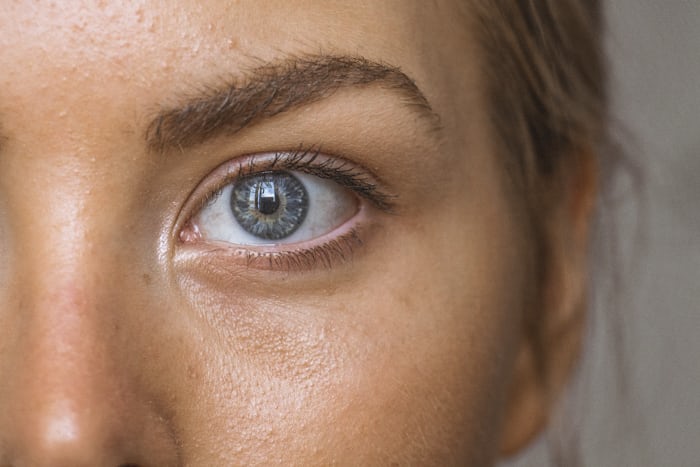If you’ve accidentally got water in eye after LASIK, you might be feeling anxious about potential complications. LASIK (Laser-Assisted In Situ Keratomileusis) is a popular refractive surgery that reshapes the cornea to improve vision. While the procedure is generally safe and effective, proper post-operative care is crucial for optimal healing. One of the key instructions patients receive is to avoid getting water in their eyes for a certain period after surgery. But what happens if you accidentally do?

Table of Contents
This article will explore the potential risks, symptoms to watch for, and steps to take if you find yourself in this situation. Remember, while it’s important to be informed, always consult with your eye surgeon for personalized advice.
What Does a Dislodged Corneal Flap Feel Like?
During LASIK surgery, a thin flap is created in the cornea and then repositioned after the laser reshaping is complete. In the days and weeks following the procedure, this flap is healing and reattaching to the eye. A major concern when water enters the eye post-LASIK is the potential for this flap to become dislodged.

If you’ve accidentally got water in your eye after LASIK and are worried about a dislodged corneal flap, here are some sensations you might experience:
- Sudden discomfort or pain: A dislodged flap often causes an immediate and noticeable sensation of discomfort.
- Feeling of something in your eye: You might feel as if there’s a foreign object in your eye, similar to having an eyelash or piece of dust trapped there.
- Increased tearing: Your eye may produce more tears than usual in response to the irritation.
- Blurred or distorted vision: If the flap has moved, it can affect your vision, causing it to become suddenly blurry or distorted.
- Light sensitivity: You might find yourself more sensitive to light than usual.
- Redness: The eye may appear redder than it has been since the surgery.
It’s important to note that these symptoms can also be caused by other factors, and not every instance of water entering the eye will result in a dislodged flap. However, if you experience any of these symptoms after water has entered your eye post-LASIK, it’s crucial to contact your eye surgeon immediately for proper assessment and care.
How Do I Know if My Corneal Flap Moved After LASIK?
Determining if your corneal flap has moved after LASIK can be challenging, as some symptoms may overlap with normal post-operative experiences. However, there are several signs that could indicate a flap complication:

- Sudden changes in vision: If you notice a sudden decrease in visual acuity or new distortions in your vision, this could be a sign of flap movement.
- Increased discomfort: While some discomfort is normal after LASIK, a sudden increase in eye pain or a feeling of pressure could indicate a problem with the flap.
- Visible irregularities: In some cases, you or someone else might be able to see an irregularity in the surface of your eye, which could indicate a displaced flap.
- Increased light sensitivity: If you become significantly more sensitive to light than you were immediately after the surgery, this could be a warning sign.
- Excessive tearing or dryness: A sudden change in your eye’s moisture level, either too wet or too dry, might indicate a flap issue.
- Difficulty blinking: If blinking becomes uncomfortable or you feel like your eyelid is catching on something, this could suggest flap displacement.
Remember, these symptoms can also be caused by other factors. If you’re concerned about your corneal flap, it’s always best to consult with your eye surgeon. They can perform a thorough examination to determine if there’s an issue with your flap.
What to Do If the Flap Moves After LASIK?
If you suspect your corneal flap has moved after LASIK, it’s crucial to act quickly and appropriately:
- Don’t rub your eye: Resist the urge to touch or rub your eye, as this could potentially worsen the situation.
- Close your eye gently: If possible, keep the affected eye closed until you can see your doctor.
- Contact your surgeon immediately: Call your LASIK surgeon’s office right away. Many practices have emergency contact numbers for situations like this.
- Seek immediate care: If you can’t reach your surgeon, go to an emergency eye care center or the emergency room. Time is crucial in addressing flap complications.
- Avoid eye drops: Unless specifically instructed by your doctor, don’t use any eye drops or medications.
- Protect your eye: If you need to go outside, wear sunglasses to protect your eye from wind and debris.
- Follow professional advice: Once you’ve seen a medical professional, follow their instructions carefully. This may include additional medications, more frequent check-ups, or in some cases, surgical intervention to reposition the flap.
- Rest and recover: After treatment, give your eye time to heal. This might mean taking time off work and limiting activities that strain your eyes.
Remember, while a moved corneal flap is a serious concern, prompt and proper medical attention can often resolve the issue successfully. Always prioritize your eye health and don’t hesitate to seek professional help if you’re worried about post-LASIK complications.

How Long Does It Take for the Flap to Reattach After LASIK?
The healing process of the corneal flap after LASIK is a gradual one, and understanding the timeline can help ease concerns about accidental water exposure.
Here’s a general overview:
- Immediate post-surgery: The flap begins to adhere within minutes of the procedure, but it’s still very delicate.
- First 24 hours: The epithelium (the outer layer of the cornea) begins to grow over the edge of the flap, helping to seal it in place.
- First week: The flap is becoming more secure, but it’s still vulnerable to dislodgement from rubbing or trauma.
- One month: By this time, the flap is typically quite stable, though not fully healed.
- Three to six months: The flap continues to heal and strengthen.
- One year: For most patients, the flap is considered fully healed and stable.It’s important to note that healing times can vary between individuals. Some people may heal faster, while others might take longer. Your eye surgeon will monitor your progress during follow-up appointments and provide personalized guidance.
Although the flap becomes more stable over time, it’s crucial to follow your doctor’s instructions throughout the entire healing process to ensure the best possible outcome.
When Can I Get My Eye Wet After LASIK?
Protecting your eyes from water is an essential part of post-LASIK care. However, the restrictions gradually ease as your eyes heal.
Here’s a general timeline for water exposure after LASIK:

- First 24 hours: Avoid all water contact. This includes not only splashing water on your face but also refraining from showering or washing your hair.
- 1-7 days: You can usually shower and wash your hair, but avoid getting water directly in your eyes. Wear goggles while showering and keep your eyes closed when washing your face or hair.
- 1-2 weeks: Swimming pools, hot tubs, and natural bodies of water should still be avoided due to the risk of infection and irritation.
- 2-4 weeks: Most surgeons allow swimming with goggles at this point, but it’s best to check with your doctor first.
- 1 month and beyond: Many patients can resume normal water activities, including swimming without goggles, but always confirm with your eye surgeon first.
Remember, these are general guidelines. Your surgeon will provide you with specific instructions based on your individual healing progress. It’s crucial to follow these personalized recommendations, even if they differ from the general timeline.
If you accidentally get water in your eye before the recommended time, don’t panic. Gently pat the area dry with a clean towel and contact your eye surgeon for advice. They may want to examine your eye to ensure there’s no damage or risk of infection. Always prioritize your eye health and when in doubt, consult with your eye care professional. They can provide the most accurate advice based on your specific situation and healing progress.
How Long After LASIK Can I Use My Phone?
In our digital age, the question of when you can return to using your smartphone after LASIK is a common concern.
Here’s what you need to know:
- First 24 hours: It’s best to avoid all screen use, including phones, computers, and televisions. Your eyes need rest to begin the healing process.
- 24-48 hours: You may be able to use your phone for short periods, but it’s crucial to take frequent breaks. Follow the 20-20-20 rule: every 20 minutes, look at something 20 feet away for at least 20 seconds.
- First week: Gradually increase screen time as comfortable, but continue to take regular breaks. Be mindful of eye strain and discomfort.
- Beyond the first week: Most patients can return to normal phone use, but it’s important to practice good digital eye health habits.

Remember these tips when using your phone after LASIK:
– Adjust screen brightness to a comfortable level
– Increase text size to reduce eye strain
– Use artificial tears if your eyes feel dry
– Blink frequently to keep your eyes moist
Always follow your eye surgeon’s specific instructions, as they may have personalized recommendations based on your healing progress. If you experience any discomfort or vision changes while using your phone, stop and contact your doctor.
How to Clean Your Eyes After LASIK
Proper eye hygiene is crucial after LASIK surgery to prevent infection and ensure optimal healing.
Here’s a guide on how to clean your eyes safely:
- Wait for the go-ahead: Don’t attempt to clean your eyes until your surgeon gives you permission, usually a day or two after surgery.
- Wash your hands: Always start with thoroughly washed and dried hands to avoid introducing bacteria to your eyes.
- Use prescribed eye drops: Your surgeon will provide medicated drops. Apply these as directed before cleaning.
• Gentle cleaning:
– Use sterile saline solution or preservative-free artificial tears.
– Moisten a clean, lint-free cloth or cotton swab with the solution.
– Gently wipe from the inner corner of your eye outward. Never wipe across your eye.
– Be extremely gentle around the eyelids and lashes.

- Avoid pressure: Don’t press or rub your eyes while cleaning.
- Skip makeup: Avoid eye makeup for at least a week after surgery, or as long as your doctor recommends.
- Protect your eyes: Wear the eye shields provided by your surgeon while sleeping for the first week or as directed.
- Be cautious of water: When showering or washing your face, keep your eyes closed and avoid direct water contact for the first week.
- Watch for signs of infection: If you notice increased redness, pain, or discharge, contact your surgeon immediately.
Remember, everyone’s healing process is unique. Your surgeon will provide personalized instructions for eye care after LASIK. Always follow these guidelines closely, and don’t hesitate to reach out to your eye care team if you have any concerns or questions about cleaning your eyes post-surgery.
Follow On:
